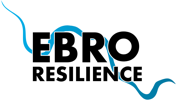The LIFE Kantauribai and LIFE Ebro Resilience P1 projects are “sister” projects with points in common that promote the exchange of experiences and knowledge. This was demonstrated in the conferences organized by the first one on October 23rd and 24th, to which the Resilience technical teams were invited to learn about different river restoration actions in Navarra and Gipuzkoa.
This networking action, launched by the common partner of both projects, Gestión Ambiental de Navarra (GAN-NIK), has allowed to analyze the solutions provided in the Kantauribai intervention area to improve the conservation of habitats and river species in Natura 2000 Network areas through the elimination and permeabilization of obstacles and the improvement of the conservation status of species (salmon, eel, shad, river mussel, Iberian desman…).


The visit to the Kantauribai area is also a response to the one held in April, which focused on Ebro Resilience actions for the adaptation and mitigation of flood risk. On this occasion, actions for the recovery of river space and adaptation of agricultural areas were toured and public participation in LIFE projects was discussed.

Common objectives
Networking is professional and personal exchange and participating in this type of actions means for LIFE Ebro Resilience P1 to weave a network of knowledge on the phenomenon of flooding, both inside and outside the territory of the middle stretch of the Ebro.
Both the LIFE project and the Ebro Resilience Strategy in which it is included include environmental restoration actions in addition to the flood risk adaptation objectives, hence the great interest in learning about the experiences carried out in other territories.
Ebro Resilience includes interventions for the recovery of river space, recovery of riverbank vegetation, elimination of invasive species and also, in the line of Kantauribai actions, the improvement of the longitudinal continuity of the river. This last group includes the works for the construction of a fish passage in the Ebro at El Bocal, Fontellas, Navarra, and the construction of another passage over the Pina weir, between the municipalities of Nuez de Ebro and El Burgo de Ebro, in Zaragoza.
Another aspect that unites both proposals is the involvement of society and the sectors related to the interventions, in the case of LIFE Ebro Resilience P1 with innovative and deep proposals for participation and social capacity building and in the case of Kantauribai because one of its objectives is to raise awareness in society, through communication and dissemination of actions and results.
Conference
In addition to a training session on the project, the technicians participating in this exchange visited several intervention areas in different basins over two days.
The first day was spent touring the river restoration areas in Navarra around the Arraioz mill and Irurita sawmill, the Endarlatsa dam on the Bidasoa River and the Bera-Lesaka salmonid monitoring station. Here the work carried out for the knowledge and protection of species was explained.
On the second day, the focus was on actions in Gipuzkoa, river restoration in Galtzaraberri in the Oiartzun basin, the Artikutza dam and the Fandería ramp on the Oiartzun river.



Coordination
The Kantauribai project works to improve the conservation status of 15 Natura 2000 Network sites, rivers and tributaries that flow into the Bay of Biscay in 5 river basins shared by 3 regions (Navarre, Gipuzkoa and Aquitaine). To this end, it brings together institutional and business partners: GAN-NIk, Cantabrian Hydrographic Confederation, Provincial Council of Gipuzkoa, Basque Water Agency, Donostia City Council, Rentería City Council, Iberdrola, ITAGRA, Conservatoire Dèspaces Narurels de Nouvelle-Aquitaine, Groupe de Recherche et d’Etude pour l’Agriculture, l’Alimentation et l’Environnement, SCINABIO and EFE Agency.
The objective of the LIFE Ebro Resilience P1 project is to mitigate the risk of flooding in the middle stretch of the Ebro, specifically with two projects in the Alfaro (La Rioja) – Castejón (Navarra) and Osera de Ebro – Fuentes de Ebro (Zaragoza) sections. Administrative coordination is one of its keys and its partners are the Ministry for Ecological Transition and the Demographic Challenge (MITECO), the Ebro Hydrographic Confederation (CHE); the Government of La Rioja; the Government of Navarra, through Gestión Ambiental de Navarra, S.A. (GAN-NIK); the Government of Aragón, the Aragonese Water Institute, TRAGSA and TRAGSATEC.



